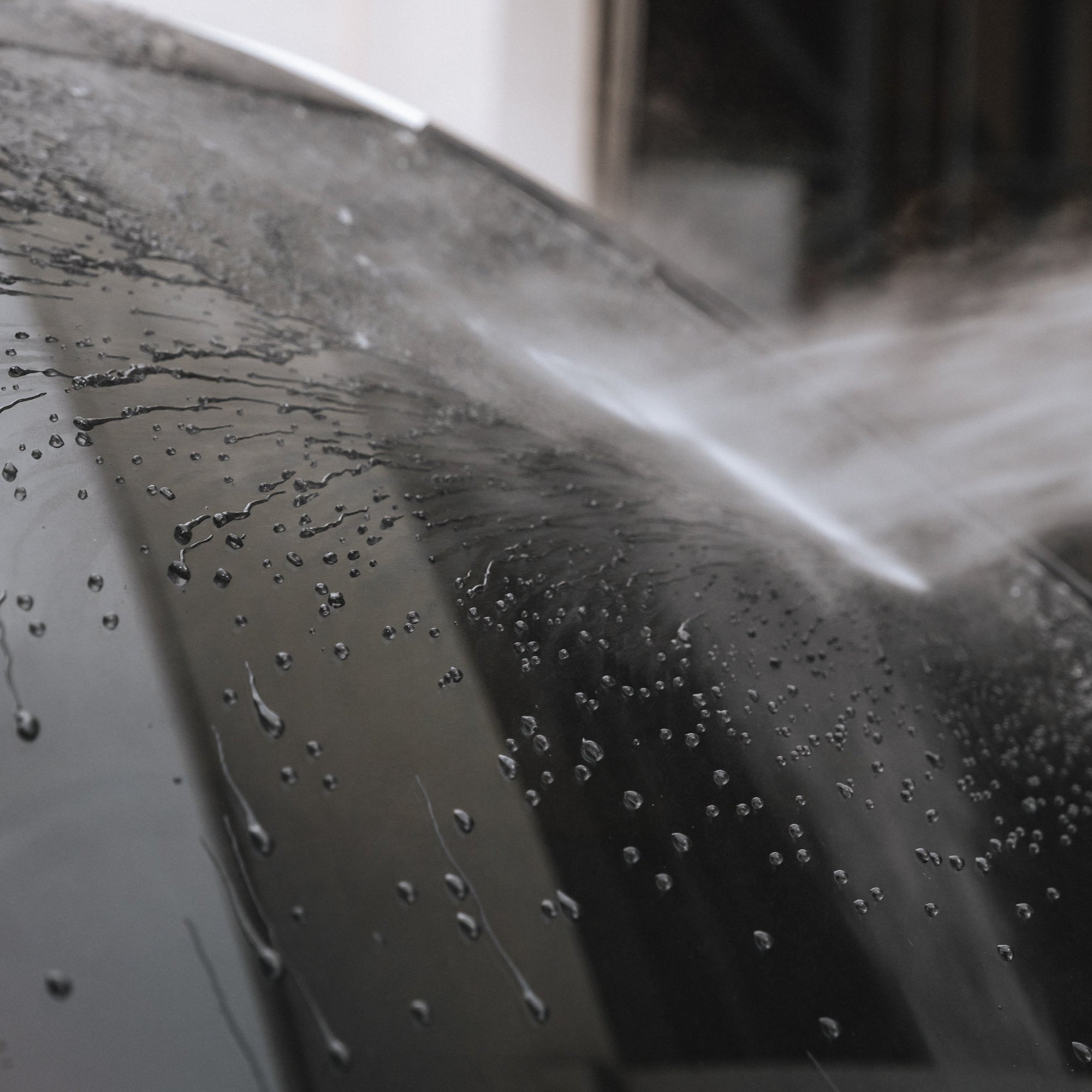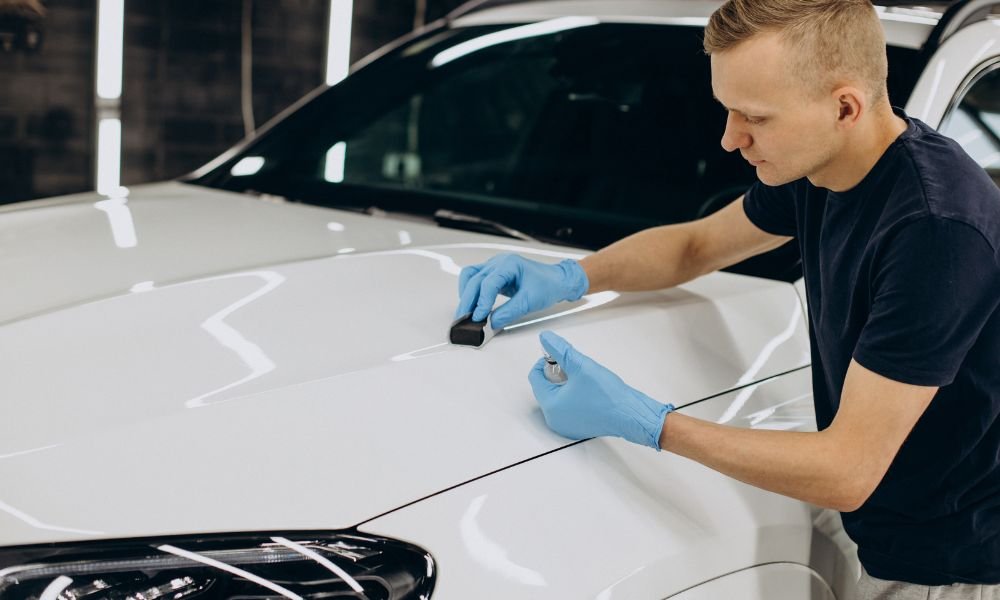Comprehending the Scientific Research Behind Ceramic Coating for Enhanced Lorry Sturdiness
The science of ceramic layer is reinventing vehicle maintenance by offering a powerful guard versus extreme environmental factors. As we discover the elaborate composition and application procedure of ceramic finishings, we uncover the keys behind their remarkable protection and long life (ceramic coating). Exactly how does this compare to typical techniques, and what implications does it have for lorry maintenance in the long term?

Composition of Ceramic Coatings
Ceramic layers are mainly composed of silicon dioxide (SiO2), which is acquired from all-natural products like quartz and sand. In enhancement to SiO2, ceramic coverings commonly include titanium dioxide (TiO2) for boosted UV protection and increased resistance to environmental contaminants.
The formula of ceramic finishes is a thorough procedure where the focus of SiO2 can significantly influence the finishing's performance. Higher SiO2 material normally leads to higher longevity and solidity, adding to the layer's ability to resist scrapes and chemical etching. Nonetheless, the equilibrium of parts is critical; also much SiO2 can make the layer weak, while inadequate can endanger its safety buildings.
Producers may additionally incorporate extra substances, such as polysilazane, to boost versatility and simplicity of application. These additives boost the finishing's hydrophobic homes, guaranteeing water and contaminants grain off the surface easily. This crafted composition emphasizes the effectiveness of ceramic coverings in safeguarding a lorry's exterior versus a range of adverse conditions.
Application Refine Described
Using a ceramic finishing to a car entails a number of critical actions, each important to ensuring ideal attachment and performance of the safety layer - ceramic coating. The process starts with a comprehensive wash and purification of the car's surface area to remove dirt, crud, and previous waxes or sealants. This action is critical as any kind of pollutants left on the surface area can hinder the finish's ability to bond successfully
Adhering to the initial cleansing, the following step includes brightening the vehicle to get rid of any kind of imperfections, such as swirl marks or scratches. Sprucing up makes certain a smooth surface, which is crucial for the coating to adhere effectively and offer a consistent finish. After polishing, a surface area preparation spray is utilized to remove any type of continuing to be residues and make certain that the surface is entirely clean.

Safety Benefits
Commonly hailed for its remarkable safety qualities, a ceramic finishing supplies numerous advantages that significantly improve vehicle longevity. At its core, ceramic covering develops a hard, semi-permanent obstacle over a vehicle's exterior, which acts as a guard against numerous ecological hazards.
Additionally, ceramic layers exhibit hydrophobic residential properties, implying they drive away water and facilitate a self-cleaning effect. This characteristic minimizes the adherence of dust and mud, streamlining upkeep and cleaning processes. The covering's resistance to chemical etching even more makes sure that the automobile's surface area remains unblemished despite exposure to severe cleaner and pollutants.
In addition to these safety advantages, the ceramic layer enhances a vehicle's aesthetic appeal by creating a shiny coating that emphasizes shade deepness and clearness. This not only sustains the car's visual appeal but additionally adds to its lasting worth by protecting the stability of its exterior over time.
Contrasting to Typical Approaches
Unlike standard techniques of vehicle protection, such as shaving or sealers, ceramic finishings provide a more sturdy and durable solution. More Bonuses Where waxes and sealers normally supply a short-term layer of protection, usually needing reapplication every few months, ceramic coatings create a semi-permanent bond with the car's paint. This bond creates a safety layer that is resistant to ecological pollutants, UV damage, and small abrasions.
Traditional waxes are largely made up of natural elements like carnauba wax, providing a shiny finish yet lacking the durable protective top qualities of ceramic finishings. Sealants, while synthetic and offering a little better durability than waxes, still drop short in comparison to the strength and chemical resistance of ceramic finishings. The advanced innovation of ceramic coatings integrates nanotechnology, which allows them to complete tiny flaws in the paint surface area, resulting in Recommended Reading a smoother and a lot more hydrophobic coating.
In terms of application, ceramic finishes require a more thorough process, commonly demanding professional setup to make certain optimal performance. This contrasts with the reasonably straightforward application of waxes and sealants, which can be used at home. Nevertheless, the premium protection and aesthetic enhancement supplied by ceramic coatings justify the investment for those seeking long-term automobile conservation.
Durability and Upkeep
Just how does the durability of ceramic finishings translate right into simplicity of maintenance for vehicle proprietors? The sophisticated formulation of ceramic layers gives a robust safety layer on the automobile's surface, which significantly expands the life expectancy of the vehicle's outside surface.
In addition, the hydrophobic nature of ceramic coverings allows water and various other fluids to bead up and roll off the surface, bring dust and particles with them. While the covering itself is resilient, it is not totally maintenance-free. Hence, ceramic coverings supply a beneficial equilibrium in between long-term resilience and simplified maintenance for automobile treatment.
Verdict
Ceramic coverings, with their advanced chemical composition of silicon dioxide and check this site out titanium dioxide, provide a formidable barrier versus ecological damages, substantially improving car sturdiness. The hydrophobic properties advertise self-cleaning, lowering upkeep efforts and preserving visual charm. When compared to traditional methods, ceramic layers supply remarkable security against UV rays, oxidation, and chemical etching. This modern technology prolongs the life expectancy of vehicle outsides, making it an ingenious service for lasting conservation and minimal maintenance.
The formulation of ceramic layers is a precise procedure where the concentration of SiO2 can dramatically influence the finish's performance.Applying a ceramic layer to a car entails several important steps, each necessary to ensuring ideal attachment and performance of the protective layer.Usually hailed for its extraordinary safety high qualities, a ceramic layer supplies countless benefits that considerably boost car sturdiness. The innovative formulation of ceramic coatings provides a durable safety layer on the automobile's surface, which dramatically expands the life-span of the cars and truck's exterior coating.Ceramic coatings, with their advanced chemical structure of silicon dioxide and titanium dioxide, supply an awesome obstacle versus ecological damages, significantly enhancing car sturdiness.